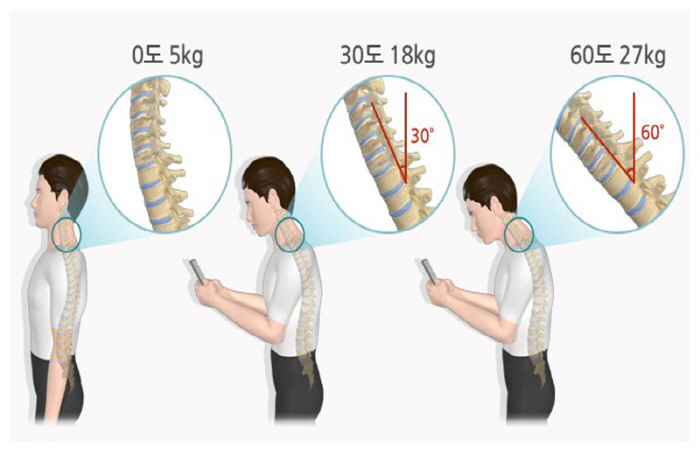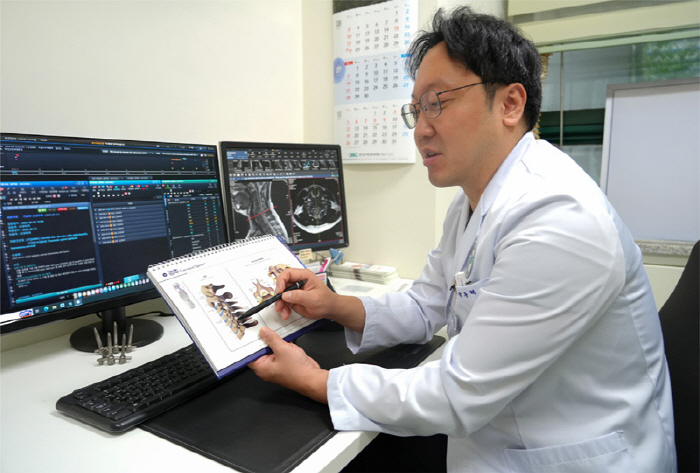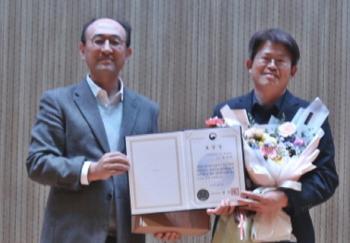You Bowing Down With Your Smartphone Calls Turtle Neck Syndrome
|
As humans evolved from quadruped walking during the apes, they changed to upright walking. This can be easily seen by a young baby. A baby crawls on all fours at first, and at this time, his head is usually bent and looking at the ground. However, after three months of age, they lift their necks and do neck-raising. From this point on, our body forms a curvature of the spine, and our neck forms a C-shape. This is because only when you take this form can you see obstacles in front of you and raise your neck to see the sky.
Park Jong-hyuk, director of the Spine Center (Neurosurgery) at Bundang Jesaeng Hospital (Hospital Director Na Hwa-yeop), said "Smartphone viewing often goes against the natural neck curve. When looking at a smartphone while sitting or standing, most of the eyes look at the screen of the smartphone and naturally lower their head. If you keep your head down for a long time, it puts tension on the back of your neck, which leads to pain."
The neck is an organ that supports the head, but the head is small in volume in the body but has a relatively high density and weight. Since humans have been walking upright, they have evolved to raise their heads as much as possible and position themselves backward to be in line with their chests. This disperses the weight of the upper body and head with the thoracic and lumbar spine and puts a relatively small burden on the neck. When we lower our necks and look at our smartphones, the weight of the head is relatively located in the front of the upper body, and the weight of the head supported by the neck is doubled.
"The act of looking at a smartphone is supported by the neck's rear muscles pulling the cervical spine and head to support the weight of the head located in front of it. The longer this time, the higher the tension and fatigue of the neck's rear muscles, and even when the head and neck return to their original position, pain and fatigue are felt," explained Park Jong-hyuk, head of the spine center.
Turtle neck syndrome is a curve formed by the opposite of the natural C-shaped curve of early humans, and is called the inverted C-shaped curve or turtle neck syndrome, which is the posture of a turtle's shrunken neck.
Manager Park Jong-hyuk said "When the turtle neck syndrome occurs, the position of the head moves forward relatively, and the tension and strength of the posterior muscles of the neck to support this head increase. Therefore, just sitting and reading books or standing and walking around can make your neck tired and painful. An important cause of turtle neck syndrome is the fixed habit and posture of keeping one's head down like looking at a smartphone. Therefore, correct posture and habits are important, and if turtle neck syndrome has begun or neck pain has occurred, it is recommended to visit a medical institution for medical treatment," he stressed.
Just as the shape and shape of a person are different, the curve of the neck varies from person to person. Some people are born with the curve of the turtle neck from birth. These people relatively rarely feel pain, even if they have turtle necks. Therefore, it is recommended to measure the posture and consult with a specialist where the weight of the head, which is an important cause of neck pain, is located in the cervical spine.
|
This article was translated by Naver AI translator.





